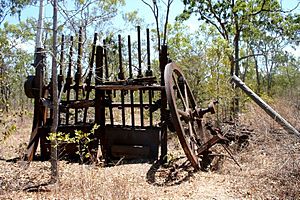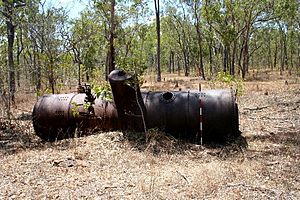Ebagoola Township and Battery facts for kids
Quick facts for kids Ebagoola Township and Battery |
|
|---|---|

Last surviving building in Ebagoola
|
|
| Location | Yarraden, Shire of Cook, Queensland, Australia |
| Design period | 1900 – 1914 (early 20th century) |
| Built | 1900–1913 |
| Official name: Ebagoola Township and Battery, Ada Stewart Battery, Ebagoolah Township | |
| Type | state heritage (archaeological, built) |
| Designated | 15 May 2006 |
| Reference no. | 601858 |
| Significant period | 1900-1910s (fabric) 1900–1913 (historical mining period) |
| Significant components | hut/shack, plantings – exotic, trees/plantings, alluvial workings, mounting block/stand, workings – shallow, terracing, machinery/plant/equipment – transport – road, mullock heap, machinery/plant/equipment – mining/mineral processing |
| Lua error in Module:Location_map at line 420: attempt to index field 'wikibase' (a nil value). | |
The Ebagoola Township and Battery is a special historical place in Queensland, Australia. It's found near Yarraden in the Shire of Cook. This site includes the remains of an old mining town and a gold processing plant called the Ada Stewart Battery. It was built between 1900 and 1913. Today, it's protected on the Queensland Heritage Register because it tells an important story about Queensland's past.
Contents
Discovering Gold: The Hamilton Goldfield
The town of Ebagoola was once a busy gold mining settlement. It was located on the Hamilton Goldfield, which is on the western side of the McIllwraith Range. This area is part of the Cape York Peninsula.
Gold was first found here in January 1900 by a prospector named John Dickie. Soon after, on July 13, 1900, the Hamilton Goldfield was officially opened. It was named after John Hamilton, a local politician and gold investor.
Gold had been found on the Cape York Peninsula before, as early as 1876. This was after the famous Palmer River goldfield attracted many people to the region. Small gold rushes happened, and by the late 1880s, a town called Coen had formed. More goldfields were discovered in the area, including Ebagoola in 1899.
Ebagoola: A Bustling Gold Town
The town of Ebagoola was planned out in September 1900. The first gold miners' camp was close to where John Dickie found gold. But the official town was built about a mile north.
People quickly bought land in the new town. Many small businesses opened up. These included a butcher shop, a general store, and a hotel. At first, the buildings were simple. They had walls made of wooden slabs and roofs of bark or canvas.
By November 1900, about 330 people lived in Ebagoola. This included miners, business owners, and families. Life was tough, and many people got sick because there wasn't enough clean water. But people believed in the town. By the end of 1900, three large hotels and several big stores had been built. Houses were being put up quickly.
The town also had a post office from 1900 to 1917. A school was open from 1905 to 1914, helping children get an education.
Growing Businesses and Gold Processing
As gold mining grew, Ebagoola became even busier in the early 1900s. New businesses arrived, like drink makers, a chemist, a baker, and barbers. There were also blacksmiths, a dressmaker, and accountants. A small hospital, run by the chemist's wife, helped the sick.
Coaches traveled from Ebagoola to Port Stewart, the closest port. This port was about 60 kilometers (37 miles) east.
At first, gold ore from Hamilton had to be sent to Coen, about 40 kilometers (25 miles) north, for crushing. By November 1900, there was only one small crushing machine on the Hamilton field. It struggled to process gold from 50 mines.
However, a lot of gold was still found. In 1900, miners found about 806 ounces of reef gold and 12,000 ounces of alluvial gold. This was worth a lot of money back then.
The Ada Stewart Battery Arrives
To help with gold crushing, the Ada Stewart battery was moved from Coen to Ebagoola. This happened at the end of 1900. A "battery" is a machine that crushes rock to get the gold out. This new battery had 10 "stamps" or heavy hammers to crush the ore. Soon after, a third battery was also set up on the goldfield.
The Decline of Ebagoola
The busy mining period in Ebagoola didn't last long. Within ten years, many mines started to close. In 1907, one battery was moved to another goldfield. The Ada Stewart battery changed owners several times.
By 1910, the population of Ebagoola had dropped to just 101 people. This was less than a third of its peak. By 1913, all the mines in Ebagoola had closed. The town was almost empty by the start of World War I in August 1914. Only one hotel, the Hamilton, was still open.
By 1924, only a few "fossickers" (people looking for small amounts of gold) remained. Tom Miller, the last person to live in Ebagoola, passed away in 1958. His old corrugated iron hut is still there today. Some of the trees planted long ago and the old street lines can also still be seen.
What Remains Today
The Ebagoola Township Site and Ada Stewart Battery are about 40 kilometers (25 miles) south of Coen. They are also about 6 kilometers (4 miles) west of the Peninsula Developmental Road. The area is mostly flat grassland.
The Ada Stewart Battery Site
The battery is located about 500 meters (1,640 feet) north of where the town used to be. You can still see parts of the battery today. It has an almost complete steel stamper frame with ten stamps. These stamps would crush the gold-bearing rock. The frame has cracks from all the vibration, but it was repaired a long time ago.
Next to it is the body of a steam engine. This engine would have powered the stamps. There are also remains of a brick base for a large boiler. The boiler itself is now lying nearby. This boiler would have created the steam for the engine.
Other parts of the gold processing plant are scattered around. These include a grinding pan, which was used for further processing the gold.
The surviving parts include:
- A ten-head stamp battery (made by Lallal Iron Coy. Foundry Ballarat)
- A Cornish boiler
- A grinding pan
- A one-cylinder steam engine
- A duplex steam pump
- Another grinding pan
The Ebagoola Township Site
The main area of the old town stretches for about 250 meters (820 feet). It follows an old station track that was once McDonald Street, the main street of Ebagoola. This area is still clear of thick plants. You can see many old trees that were planted by the residents. These include large mango trees, tamarind trees, and several date palms.
There isn't much left of the old buildings. You might find scattered pieces of corrugated iron and wooden stumps. These are often found near the old mango trees. You can also find old bottle and rubbish dumps, and the remains of an old wagon.
The only building still standing in the old town is a small corrugated iron hut. This hut belonged to Tom Miller, the last resident of Ebagoola. It's still in good condition inside, with some old furniture. Near the hut, you can see more old glass, metal, and other items. There's also a metal drum sunk into the ground, which was probably an old toilet.
Gold Workings
Around the town site, you can see many signs of the old gold mining. These are called "workings." They are shallow pits and ditches that stretch for about 1 kilometer (0.6 miles). There are also "mullock dumps," which are piles of waste rock from the mines. You can find old machinery parts here too.
One large mullock dump is about 6 meters (20 feet) high. Near it, you can see a broken piece of machinery and an almost complete vertical boiler.
On the eastern side of the town, along a creek, there are also signs of "alluvial diggings." This is where miners searched for gold in riverbeds and loose soil. In the southeast, you can find more shallow pits and mullock dumps along a fence line.
Why This Place is Important
The Ebagoola Township and Battery was added to the Queensland Heritage Register on May 15, 2006. It's important for several reasons:
- It shows how Queensland's history developed. The site shows how mining towns grew and then faded away on the remote Cape York Peninsula. The old street lines and the trees planted by the residents still mark where the town once stood. The combination of the Ada Stewart Battery, the mining areas, and the town site helps us understand the Hamilton Goldfield. It also shows how small but busy gold mining worked in far north Queensland in the early 1900s. The Ada Stewart Battery is special because it shows how important it was to have crushing machines on distant goldfields. It also shows how equipment was often moved from one goldfield to another as new opportunities arose.
- It shows rare parts of Queensland's history. Some of the old machinery here is very rare. The flat-bed engine is uncommon, even though it's broken. The 10-head battery is one of only two complete ones in the Cook Shire. Tom Miller's hut is also rare because it's still in such good condition for an abandoned mining town. Having the mining areas, the battery, and the town all together in one place is also quite unusual in Queensland.
- It shows what a goldfield was like. The way the Ebagoola town and battery are laid out, along with the remaining buildings and earthworks, helps us understand what an early, busy goldfield in far north Queensland was like. The battery includes the 10-head stamper, boiler, grinding pans, and other parts. The town site has old house locations, trees, and cattle yards. Miller's hut is a good example of the simple homes found in early mining camps in North Queensland.
Images for kids




